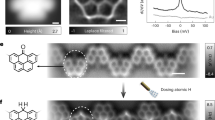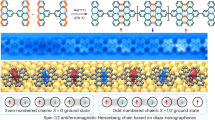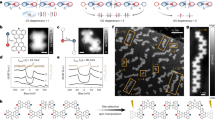Abstract
Spin-1/2 Heisenberg antiferromagnetic chains are one-dimensional platforms that are excellent for exploring quantum magnetic states and quasiparticle fractionalization. Understanding quantum magnetism and quasiparticle excitation at the atomic scale is crucial for manipulating the quantum spin systems. Here we report the fabrication of spin-1/2 Heisenberg chains through on-surface synthesis and in situ reduction. A closed-shell nanographene is employed as a precursor for Ullmann coupling to avoid side reactions, thus obtaining oligomer chains. Following exposure to atomic hydrogen and tip manipulation, the closed-shell polymers are transformed into spin-1/2 chains with controlled lengths by reducing ketone groups and subsequent hydrogen desorption. The spin excitation gaps are found to decrease in a power law as the chain lengthens, suggesting a gapless feature in the thermodynamic limit. Interestingly, the spinon dispersion is extracted from the inelastic spectroscopic spectra, agreeing well with calculations. Our results demonstrate the great potential of fabricating desired quantum systems through a combined on-surface synthesis and reduction approach.

This is a preview of subscription content, access via your institution
Access options
Subscribe to this journal
Receive 12 digital issues and online access to articles
118,99 € per year
only 9,92 € per issue
Buy this article
- Purchase on SpringerLink
- Instant access to full article PDF
Prices may be subject to local taxes which are calculated during checkout




Similar content being viewed by others
Data availability
All data generated in this study are available via figshare at https://doi.org/10.6084/m9.figshare.28091300 (ref. 48).
Code availability
The relevant codes are available via GitHub at https://github.com/Suxl1994/spin_chain_ED.
References
Haldane, F. D. M. Nonlinear field theory of large-spin heisenberg antiferromagnets: semiclassically quantized solitons of the one-dimensional easy-axis Néel state. Phys. Rev. Lett. 50, 1153–1156 (1983).
Affleck, I., Kennedy, T., Lieb, E. H. & Tasaki, H. in Condensed Matter Physics and Exactly Soluble Models (eds Nachtergaele, B. et al.) Ch. 18, 249–252 (Springer, 2004).
White, S. R. & Huse, D. A. Numerical renormalization-group study of low-lying eigenstates of the antiferromagnetic S = 1 Heisenberg chain. Phys. Rev. B 48, 3844–3852 (1993).
White, S. R. Density-matrix algorithms for quantum renormalization groups. Phys. Rev. B 48, 10345–10356 (1993).
Kenzelmann, M. et al. Structure of end states for a Haldane spin chain. Phys. Rev. Lett. 90, 087202 (2003).
Bethe, H. Zur theorie der metalle: I. Eigenwerte und eigenfunktionen der linearen atomkette. Z. Phys. 71, 205–226 (1931).
Lieb, E., Schultz, T. & Mattis, D. Two soluble models of an antiferromagnetic chain. Ann. Phys. 16, 407–466 (1961).
Affleck, I. & Lieb, E. H. A proof of part of Haldane’s conjecture on spin chains. Lett. Math. Phys. 12, 57–69 (1986).
Mourigal, M. et al. Fractional spinon excitations in the quantum Heisenberg antiferromagnetic chain. Nat. Phys. 9, 435–441 (2013).
Schlappa, J. et al. Probing multi-spinon excitations outside of the two-spinon continuum in the antiferromagnetic spin chain cuprate Sr2CuO3. Nat. Commun. 9, 5394 (2018).
Choi, D. J. et al. Colloquium: atomic spin chains on surfaces. Rev. Mod. Phys. https://doi.org/10.1103/RevModPhys.91.041001 (2019).
Toskovic, R. et al. Atomic spin-chain realization of a model for quantum criticality. Nat. Phys. 12, 656–660 (2016).
Yang, K. et al. Probing resonating valence bond states in artificial quantum magnets. Nat. Commun. 12, 993 (2021).
Clair, S. & de Oteyza, D. G. Controlling a chemical coupling reaction on a surface: tools and strategies for on-surface synthesis. Chem. Rev. 119, 4717–4776 (2019).
Ruffieux, P. et al. On-surface synthesis of graphene nanoribbons with zigzag edge topology. Nature 531, 489–492 (2016).
de Oteyza, D. G. et al. Direct imaging of covalent bond structure in single-molecule chemical reactions. Science 340, 1434–1437 (2013).
Rizzo, D. J. et al. Topological band engineering of graphene nanoribbons. Nature 560, 204–208 (2018).
Groning, O. et al. Engineering of robust topological quantum phases in graphene nanoribbons. Nature 560, 209–213 (2018).
Cirera, B. et al. Tailoring topological order and pi-conjugation to engineer quasi-metallic polymers. Nat. Nanotechnol. 15, 437–443 (2020).
Li, J. et al. Topological phase transition in chiral graphene nanoribbons: from edge bands to end states. Nat. Commun. 12, 5538 (2021).
Mishra, S. et al. Synthesis and characterization of pi-extended triangulene. J. Am. Chem. Soc. 141, 10621–10625 (2019).
Cheng, S. et al. On-surface synthesis of triangulene trimers via dehydration reaction. Nat. Commun. 13, 1705 (2022).
Du, Q. et al. Orbital-symmetry effects on magnetic exchange in open-shell nanographenes. Nat. Commun. 14, 4802 (2023).
Hieulle, J. et al. On-surface synthesis and collective spin excitations of a triangulene-based nanostar. Angew. Chem. Int. Ed. 60, 25224–25229 (2021).
Song, S. et al. Highly entangled polyradical nanographene with coexisting strong correlation and topological frustration. Nat. Chem. 16, 938–944 (2024).
Zheng, Y. et al. Designer spin order in diradical nanographenes. Nat. Commun. 11, 6076 (2020).
Zhao, Y. et al. Quantum nanomagnets in on-surface metal-free porphyrin chains. Nat. Chem. https://doi.org/10.1038/s41557-022-01061-5 (2022).
Zhao, C. et al. Tunable topological phases in nanographene-based spin-1⁄2 alternating-exchange Heisenberg chains. Nat. Nanotechnol. 19, 1789–1795 (2024).
Lado, J. L. & Fernández-Rossier, J. Magnetic edge anisotropy in graphenelike honeycomb crystals. Phys. Rev. Lett. 113, 027203 (2014).
Fu, X. et al. Building spin-1/2 antiferromagnetic Heisenberg chains with diaza-nanographenes. Preprint at https://doi.org/10.48550/arXiv.2407.20511 (2024).
Sun, K. et al. Heisenberg spin-1/2 antiferromagnetic molecular chains. Preprint at https://doi.org/10.48550/arXiv.2407.02142 (2024).
Xiang, Q., Ye, L., Ma, L. & Sun, Z. The olympicenyl radical and its derivatives. ChemPlusChem 89, e202300571 (2024).
Zhu, X. et al. Topological structure realized in cove-edged graphene nanoribbons via incorporation of periodic pentagon rings. J. Am. Chem. Soc. 146, 7152–7158 (2024).
Lawrence, J. et al. Circumventing the stability problems of graphene nanoribbon zigzag edges. Nat. Chem. 14, 1451–1458 (2022).
Wang, T. et al. Aza-triangulene: on-surface synthesis and electronic and magnetic properties. J. Am. Chem. Soc. 144, 4522–4529 (2022).
Gross, L., Mohn, F., Moll, N., Liljeroth, P. & Meyer, G. The chemical structure of a molecule resolved by atomic force microscopy. Science 325, 1110–1114 (2009).
Pavlicek, N. et al. Synthesis and characterization of triangulene. Nat. Nanotechnol. 12, 308–311 (2017).
Mistry, A. et al. The synthesis and STM/AFM imaging of ‘olympicene’ benzo[cd]pyrenes. Chemistry 21, 2011–2018 (2015).
Li, J. et al. Single spin localization and manipulation in graphene open-shell nanostructures. Nat. Commun. 10, 200 (2019).
Su, X. et al. Atomically precise synthesis and characterization of heptauthrene with triplet ground state. Nano Lett. 20, 6859–6864 (2020).
Zhao, C. et al. Gapless spin excitations in nanographene-based antiferromagnetic spin-1/2 Heisenberg chains. Preprint at https://doi.org/10.48550/arXiv.2408.10045 (2024).
Jiménez-Martín, A. et al. Atomically precise control of topological state hybridization in conjugated polymers. ACS Nano 18, 29902–29912 (2024).
Ternes, M. Spin excitations and correlations in scanning tunneling spectroscopy. New J. Phys. https://doi.org/10.1088/1367-2630/17/6/063016 (2015).
des Cloizeaux, J. & Pearson, J. J. Spin-wave spectrum of the antiferromagnetic linear chain. Phys. Rev. 128, 2131–2135 (1962).
Fernández-Rossier, J. Theory of single-spin inelastic tunneling spectroscopy. Phys. Rev. Lett. 102, 256802 (2009).
Yuan, Z. et al. Fractional spinon quasiparticles in open-shell triangulene spin-1/2 chains. J. Am. Chem. Soc. https://doi.org/10.1021/jacs.4c14712 (2025).
Renard, J. P., Regnault, L. P. & Verdaguer, M. in Magnetism: Molecules to Materials (eds Miller, J. S. & Drillon, M.) Ch. 2, 49–93 (Wiley, 2002).
Su, X., et al. Dataset for ‘Fabrication of spin-1/2 Heisenberg antiferromagnetic chains via combined on-surface synthesis and reduction for spinon detection’. figshare https://doi.org/10.6084/m9.figshare.28091300 (2024).
Acknowledgements
P.Y. gratefully acknowledges the financial support from the National Natural Science Foundation of China (22472098), Science and Technology Commission of Shanghai Municipality (24ZR1452100) and ShanghaiTech start-up funding. X.S. acknowledges the Postdoctoral Science Foundation of China (2021M702188). C.L. acknowledges the NSFC grant 12304230 and Postdoctoral Science Foundation of China (grant GZB20230422). Y.-F.J. acknowledges support from the National Program on Key Research Project (grant no. 2022YFA1402703). We also thank Fermion Instruments for supplying the hydrogen cracker source.
Author information
Authors and Affiliations
Contributions
X.S., Z.D., Y.H. and P.Y. conceived the project. X.S., Z.D. and P.Y. acquired and analysed the experimental data. N.K., C.L. and Y.-F.J. performed all the calculations. Y.H. and K.Y. designed and synthesized the molecular precursors. All the authors discussed and contributed to the paper writing.
Corresponding authors
Ethics declarations
Competing interests
The authors declare no competing interests.
Peer review
Peer review information
Nature Synthesis thanks Jiong Lu, Shiyong Wang and the other, anonymous, reviewer(s) for their contribution to the peer review of this work. Primary Handling Editor: Peter Seavill, in collaboration with the Nature Synthesis team.
Additional information
Publisher’s note Springer Nature remains neutral with regard to jurisdictional claims in published maps and institutional affiliations.
Supplementary information
Supplementary Information
Supplementary Figs. 1–18 and experimental details.
Supplementary Data
The source data for Supplementary Figs. 11, 15b and 17a–c.
Source data
Source Data Fig. 1
The source data for STM and AFM images in Fig. 1.
Source Data Fig. 2
The source data for AFM images, STS and simulated spectra in Fig. 2.
Source Data Fig. 3
The source data for calculated and experimental spin excited energies of OSCs in Fig. 3.
Source Data Fig. 4
The source data for AFM images, STM images, STS, and experimental and calculated spinon dispersion in Fig. 4.
Rights and permissions
Springer Nature or its licensor (e.g. a society or other partner) holds exclusive rights to this article under a publishing agreement with the author(s) or other rightsholder(s); author self-archiving of the accepted manuscript version of this article is solely governed by the terms of such publishing agreement and applicable law.
About this article
Cite this article
Su, X., Ding, Z., Hong, Y. et al. Fabrication of spin-1/2 Heisenberg antiferromagnetic chains via combined on-surface synthesis and reduction for spinon detection. Nat. Synth 4, 694–701 (2025). https://doi.org/10.1038/s44160-025-00744-4
Received:
Accepted:
Published:
Issue Date:
DOI: https://doi.org/10.1038/s44160-025-00744-4
This article is cited by
-
Building spin-1/2 antiferromagnetic Heisenberg chains with diaza-nanographenes
Nature Synthesis (2025)
-
Spin-1/2 Heisenberg chains realized in π-electron systems
Nature Synthesis (2025)
-
Spins in chains
Nature Materials (2025)



